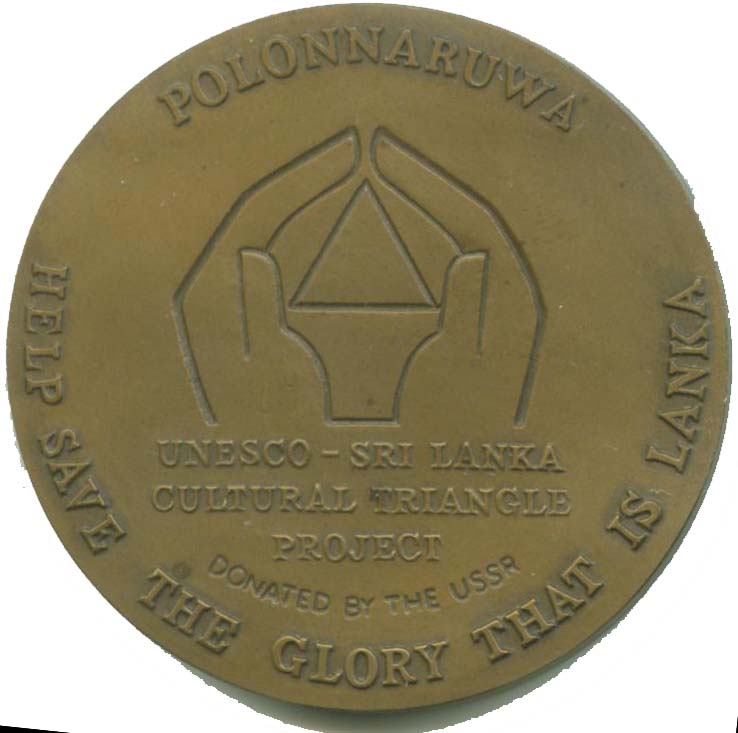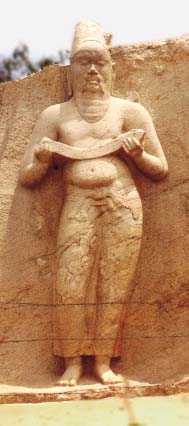| SPECIFICATIONS | |
| Alloy | Brass |
| Type | Struck |
| Diameter | 59.8 mm |
| Thickness | 6.9 mm |
| Weight | ~113 gms |
| Shape | Round |
| Edge | Plain |
| Die Axis | 0° |
| Mint | USSR |


|

| 
| ||||||||||||||||||||
International Council on Monuments and Sites in it's 1981 evaluation said
 After the destruction of Anuradhapura in 993 by Rajaraja, Polonnaruwa,
a temporary royal residence during the 8th century, became a
capital. The conquering Cholas constructed monuments to their religion
- Brahmanism - and especially temples to Shiva where admirable bronze
statues, today in the museum of Colombo, were found.
After the destruction of Anuradhapura in 993 by Rajaraja, Polonnaruwa,
a temporary royal residence during the 8th century, became a
capital. The conquering Cholas constructed monuments to their religion
- Brahmanism - and especially temples to Shiva where admirable bronze
statues, today in the museum of Colombo, were found.
The reconquest of Lanka by Vijayabahu I did not put an end to the city's role as capital,but it becomes covered, after 1070, with Buddhist sanctuaries of which the Atadage, (Temple of the Tooth Relic) is the most renowned.
The apogee of Polonnaruwa occurred in the 12th century a.d. Two sovereigns, then proceeded to endow it with monuments. Parakramabahu I (1153-1186) created within a triple walled enceinte, a fabulous garden-city, where palaces and sanctuaries prolonged the enchantment of the countryside. The following monuments date from his reign : the Lankatilaka, an enormous brick structure which has preserved a colossal image of Buddha; the Gal Vihara, with its gigantic rock sculptures which may be placed among the chefs-d'oeuvre of Sinhala art; the Tivanka Pilimage, where wall paintings of the 13th century illustrate the jataka (narratives of the previous lives of Buddha, etc. Nissankamalla (1187-1196) constructed, in haste, monuments which, though less refined than those of Parakramabahu I, were nonetheless splendid : the Rankot Vihara, an enormous stupa, measuring 175 meters in diameter and 55 meters in height, is one of the most impressive; its plan and its dimensions are reminiscent of the dagabas of Anuradhapura.
After this golden age, Polonnaruwa underwent a century of difficulties, before its difficulties decline. The city which was invaded by the Tamils and the Maghas, then reconquered in a precarious manner, was only periodically the capital before the end of the 13th century when it was captured in an assault by Bhuvanaikabahu II, who set up his government at Kurunegala.
ICCMOS recommends the inscription of Polonnaruwa on the World Heritage List on the basis of criteria I, III and VI.
Criterion I The immense capital created by the megalomaniac sovereign, Parakramabahu I, in tne 12th century, is one of history's most astonishing urban creations, both because of its unusual dimensions and because of the very special relationship of its buildings with the natural setting.
Criterion III. Polonnaruwa attests in a exceptional manner to several civilizations, notably that of the conquering Cholas, disciples of Brahmanism, and that of the Sinhala sovereigns during the 12th and 13th centuries.
Criterion VI. It is a shrine of BuddhiSt and of Sinhala history. It is sufficient to recall that the tooth of Buddha, remarkable relic placed in tne Atadage under Vijayabahu, was considered as the talisman of the Sinhala monarchy : its removal by Bhuvanaikabahu II confirmed the decline of Polonnaruwa.
For a beautiful interactive spherical panoramic views of Gal Vihara look at image which is one of 10 images for Ancient city of Polonnaruwa Heritage site. It does not however include as yet the most famous statue shown on medal.
The medal which is one of a set of six were minted in 1987 and donated by USSR, to Central Cultural Fund (CCF) probably as a fund raiser.
The Medal was scanned at 300 dpi and displayed at 100 dpi. It was purchased in 2005 March from CCF office in Kandy.